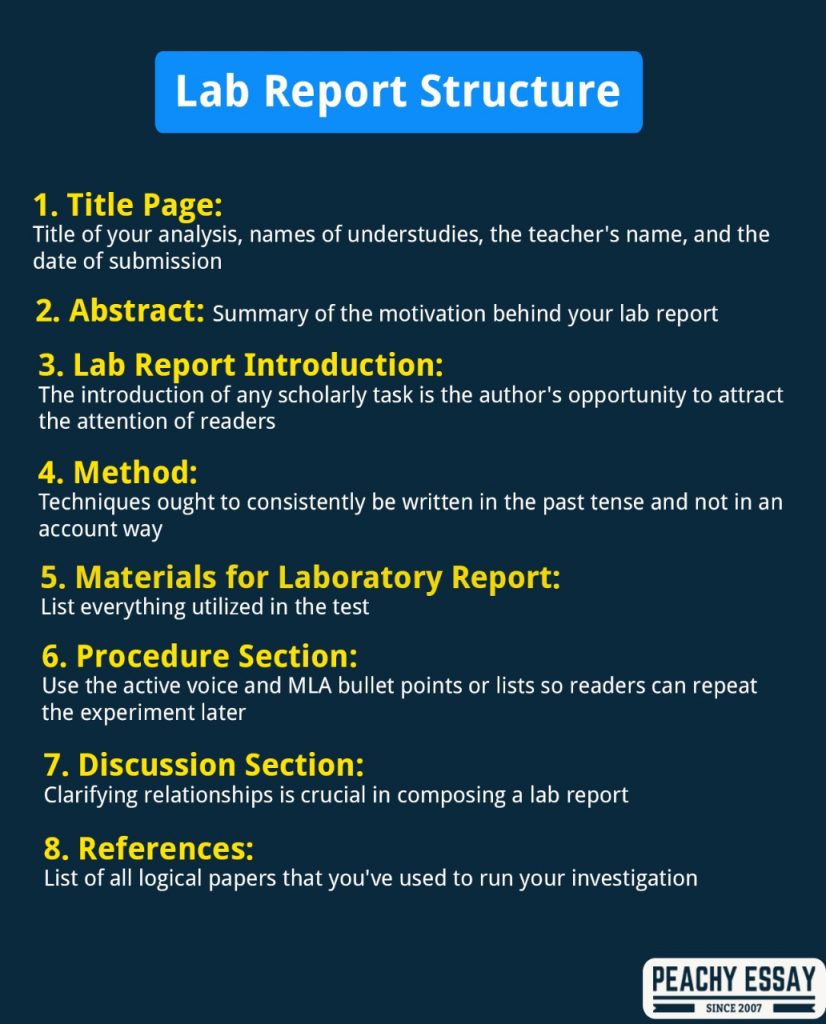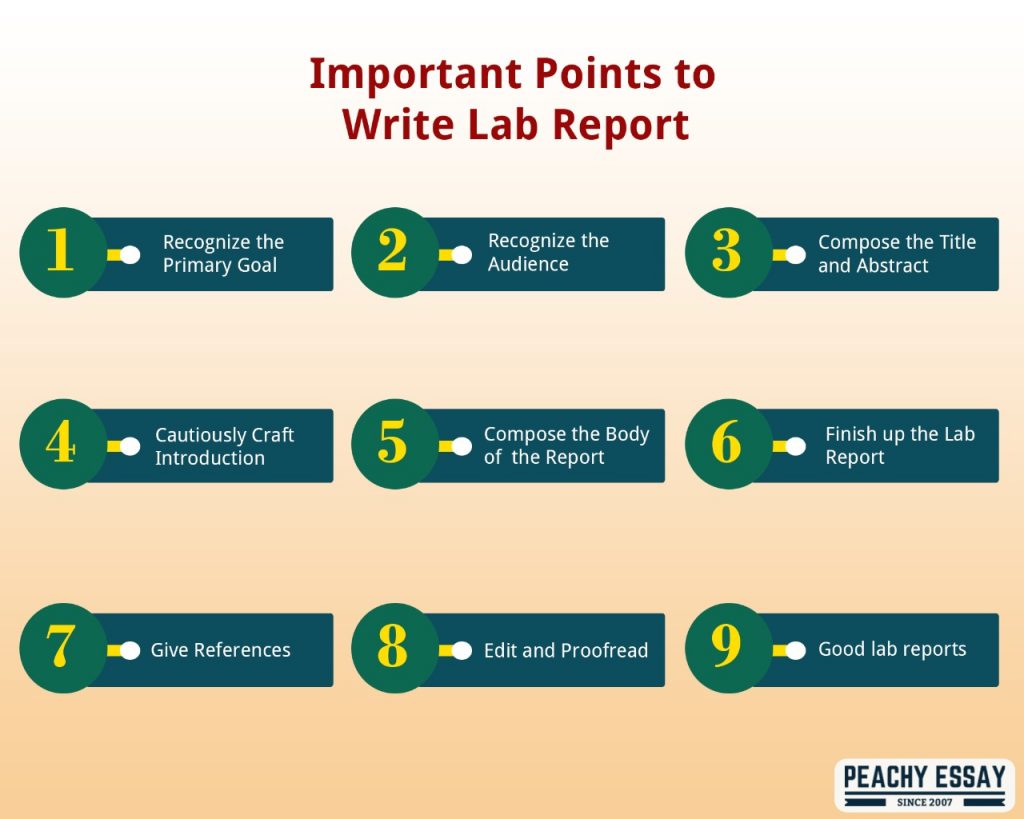Composing a lab report may appear as though a troublesome assignment for some understudies but in reality, it is simple if you plan the report composing ahead. The top page on a lab report ought to be the cover sheet where you put a couple of data lines, including the title of the investigation, the name of understudies taking an interest in the test, and the name of your teacher. You should likewise not neglect to remember the date of the investigation for the lab report. In the lab report, you should incorporate the reason for conducting the test. To determine the motivation behind the test, you should find out if you are attempting to tackle an issue or testing something in the experiment.
Lab reports are an essential part of all research facility courses and typically a huge piece of your evaluation. If your instructor gives you an outline for how to compose a lab report, utilize that. A few instructors require a lab report to be included in a lab notebook, while others will demand a different report.
What is a lab report?
Lab reports are an important piece of the courses that require fundamental lab tests and trials. They are objective and are a complete record of a test. The data provided in a lab report is explicit enough that the reader gets a clear picture of the investigation completed by the analyst.
It contributes a great deal in accomplishing better evaluations in an understudy’s scholarly life. Much the same as each other scholarly task, lab reports are to be created with a legitimate structure.
A trustworthy lab report tends to the discoveries and shows the essayist’s ideas and comprehension of the test. Detailing just the outcomes and the crude information isn’t sufficient. It is critical to introduce why and how the outcomes happened.
A lab report is a manner by which you clarify what you did in your analysis, what you realized, and what the outcomes implied.
What is the purpose of a lab report?
The principal reason for a lab report is, to sum up, the scientific research you’ve performed and clarify how the outcomes identify with your theory. Specialized reports like these are a significant piece of science on the grounds that, as a researcher, you have a duty to communicate your findings, what you learned, and why it is important.
The Structure of a Lab Report
A conventional lab report has a few significant parts. It is advisable to finish your task in incredible quality, focus on each part, and work on it appropriately.

-
Title page
Some lab reports don’t need a cover sheet. However, in the event that your educator requests one, notice the title of your analysis, names of understudies, the teacher’s name, and the date of submission.
-
Abstract
This is a summary of the motivation behind your lab report. It ought to clarify the key findings and significant conclusions. Indicate the philosophy or hypothesis on which the investigation is based. By perusing the abstract, intrigued readers will have a thought of what they will peruse.
It ought to be brief, and still contain all significant data, including the mathematical estimations of results. It ought to likewise incorporate a summed up depiction, everything being equal.
-
Lab Report Introduction
The introduction of any scholarly task is the author’s opportunity to attract the attention of readers. Your lab report presentation is an outline of the significant strides in the trial while referencing some foundation data. Highlight your hypothesis or what you accept prior to running an experiment to prove it. Your introduction should mention to readers what is the issue and clarify how your experiment can expand information to settle this issue.
-
Method
Your method area is a necessary piece of a conventional lab report. Techniques ought to consistently be written in the past tense and not in an account way. Lab report composing depends on facts and ought to follow a logical methodology. Notice the approach or hypotheses and factors that will influence results. Techniques adjusted from different sources ought to be referred to.
-
Materials for Laboratory Report
Here understudies list everything utilized in the test. This allows readers to duplicate the investigation if they wish to. Utilize total sentences and don’t list materials like a formula.
-
Procedure Section
Don’t confuse readers by composing such a large number of words. Keep it simple and list activities in the order they occurred. Use the active voice and MLA bullet points or lists so readers can repeat the experiment later on if they wish. While composing your test system, you ought to try not to be excessively brief; else, you may surrender clarity.
-
Discussion Section
Clarifying relationships is crucial in composing a lab report. How does your investigation identify with other work in a similar field? This is the thing that you need to remember for your lab report conversation to give valuable data to readers. You have presumably gotten a few questions in your lab manual. In the conversation segment, incorporate these answers into a sensible discussion instead of noting them individually.
-
References
This is a list of all logical papers that you’ve used to run your investigation. References ought to be composed on a different page toward the finish of your task. Readers can allude to these references if they need to understand more. This is likewise a decent method to try not to be blamed for plagiarism.
How to Write a Lab Report?
Whether you are studying chemistry, microbiology, or physics, composing top-notch lab reports is crucial for scholarly studies. Hopeful researchers and understudies need a decent lab report when they’re creating something, prove facts, or expand on findings. That is the reason each science understudy ought to figure out how to compose a conventional lab report that meets sufficient scholastic rules.
This isn’t simply one more bit of scholastic thinking of you need to deliver expecting good grades. It’s an opportunity to show a comprehension of a specific subject by making determinations.
Composing a lab report is a precarious occupation as it requires a few significant strides. Regardless of which kind of lab report you are composing and for which level, there is a fundamental composing structure that works for all.
At the point when an understudy composes a report unexpectedly, it is basic to get familiar with the basics. With no basics, the writing process can be challenging.
The lab report composing comprises the following information:
The context of the study: Contains relevant foundation and data about the analysis, and it is written in the past tense.
The methods applied: If you are composing a lab report for your scholastics and teacher, ensure you are making the correct composing strides.
The following are the steps in which a lab report is written.

-
Recognize the Primary Goal
When composing a lab report, the essential objective is to ensure that it is clear and reasonable to the reader. Regardless of whether you are composing a lab report for your teacher, ensure it tends to be assessed. Remembering the essential objective will help the author in writing every section of the lab report.
-
Recognize the Audience
For each composing type, it is basic to recognize who you are composing it for. Also, when composing a lab report, decide the focus on the audience first. If you are composing the report for scholastics, your audience will be your educator.
In the event that the audience is of another discipline, make a point to clarify the language and specialized terms utilized. It is to make your report justifiable for everybody.
-
Compose the Title and Abstract
The title and the abstract are the two generally noticeable and striking pieces of a lab report. These two components will assist the author in standing out enough to be noticed by the readers, so they ought to be composed perfectly.
To make your title fascinating, ensure that it reflects what you have done in the investigation and some intriguing discoveries. For your abstract, keep it brief. It ought to be founded on only one paragraph of 200 words.
The abstract of a lab report contains the following information:
- The essential inspiration or reason for the trial
- How does your investigation vary from the past one?
- The procedure used to get test results.
- Vital discoveries, assuming any
-
Cautiously Craft Introduction
All reports start with an introduction. The acquaintance area is composed to give the audience a superior comprehension of what will occur. This section answers the following questions:
- What is the setting of the issue?
- What is the issue you are attempting to settle?
- For what reason is the issue imperative to talk about?
- Is the issue settled, or is it still unsolved?
Alongside the foundation, the introduction contains critical data about the test or the report. This incorporates:
- For what reason was the issue so hard to tackle?
- How did the author tackle the issue?
- The conditions in which the results are relevant
- Major results
- How have you coordinated your report?
Remember to give all the data plainly in the introduction segment with the goal that readers can comprehend and feel persuaded to realize what is there in your lab report.
-
Compose the Body of the Report
The body segment contains all the data about the materials utilized for the trial and the techniques. Composing this segment plans to illuminate the readers about the equipment and theories, which gets the ideal outcomes.
Methods and theories include the following information:
- The material and theory are described absolutely in a paragraph.
- A diagram of the apparatus is presented.
- Natural and derived theoretical elements are provided
- The procedures and methodologies utilized for the investigation.
Also, the report’s body segment incorporates other data like the understanding of the work and a separation between the past and the current works. If the examination you are leading has been performed previously, decipher how it guided you to distinguish the distinctions simply. This data can be introduced just after the introduction and toward the finish of the body segment, contingent upon the essayist’s inclination.
The distinctions can be introduced as diagrams or charts to make them understandable. While giving a reference to the other’s work, try to refer to it appropriately. It is to dodge plagiarism and guarantee the legitimacy of your work.
In the wake of giving the data in setting to the past work, express your outcomes obviously. Your examination results will be founded on the lab you have worked on, how it performed, its implementations, and the objective of the experiment. Present all the information from your test in this information without giving personal opinions and subjective comments.
The results area consistently remains objective, regardless of whether your information affirms the theory.
Finish up the Lab Report
The conclusion or conversation segment is the place where the interpretation of the numerical information and results are made. Likewise, forecasts are given in this piece of the report as well.
-
Give References
If there have been numerous sources used, they ought to be cited within the text. Counsel the lab manual to decide the referencing style.
-
Edit and Proofread
The last and most significant step is to edit all that is written in the report. It is to guarantee your lab report’s quality and exactness, which makes you and your work valid. Re-check everything about your report and ensure that it is free from errors.
-
Good lab reports
To compose the ideal lab report, you need to consider who you’re composing for and what they need to know. Compose the report as though your reader has a similar degree of experience as you, i.e., an understudy taking a similar course but in an alternate lab area. The appearance of your lab report may fluctuate dependent on your research, however, you ought to consistently mean to:
Communicate the discoveries from your work and assist your reader with getting them.
Compose your methodology with enough detail that your analysis and results could be duplicated later.
Compose each part of the report with enough detail that your motivation, theory, and reasoning are surely known.
Tell your reader a logical story about what was done, what the outcomes were, and your translation of the discoveries.
Pass on fundamental data as succinctly and adequately as could reasonably be expected.
Bad lab reports
Awful lab reports are frequently composed last minute and do not have an overall comprehension of the investigation. Begin your report adequately early and ask a companion or two to audit it for you. In the event that your companions don’t comprehend what is the issue here, it’s safe to assume the person grading your report won’t either.
The Best Tips on Writing a Lab Report
Here are the tips to assist you with composing powerful lab reports generally.
- Try not to compose your lab report in the first person. Scholastic papers like lab reports ought to be written in the third person only.
- At whatever point you use abbreviations in your lab report, ensure you spell out their meaning when mentioning them for the first time in the text.
- Focus on your techniques and material segment toward the individuals who are inexperienced with the subject; clarify everything in detail.
- In the event that something didn’t go well during the investigation, expound on it, in any case, to help prevent a reader from committing a similar error. If you conducted a risky stage a subsequent time and accomplished a more fruitful result, expound on that too.
- If the information that you have gotten during the experiment doesn’t support your hypothesis, you ought to likewise specify it in the content.
- Try not to attempt to manipulate the outcomes in the event that you realize that they may be affected by deviated data. It is smarter to take the ‘special data ‘ into the record and notice that the outcomes may be accidental. At the end of the day, while recreating the analysis, someone else probably won’t get similar information.
- If it is possible, relate your outcomes to different investigations on the point. For instance, you may get results that complement some other investigation, or bring another viewpoint on a contentious hypothesis. In doing such, you will exhibit that your analysis is a piece of a greater picture.


